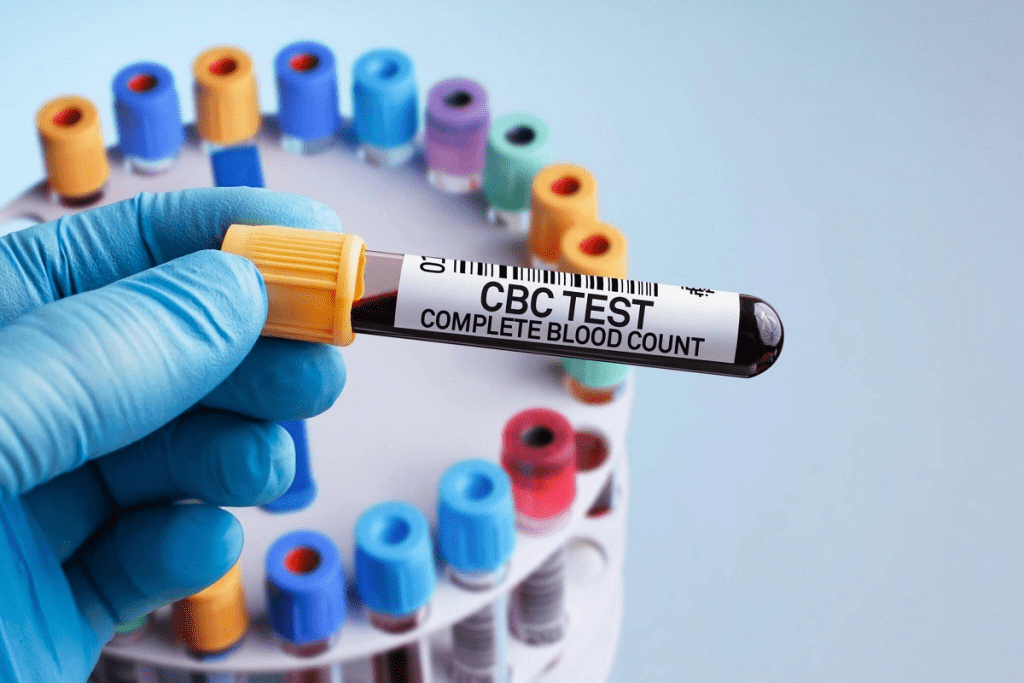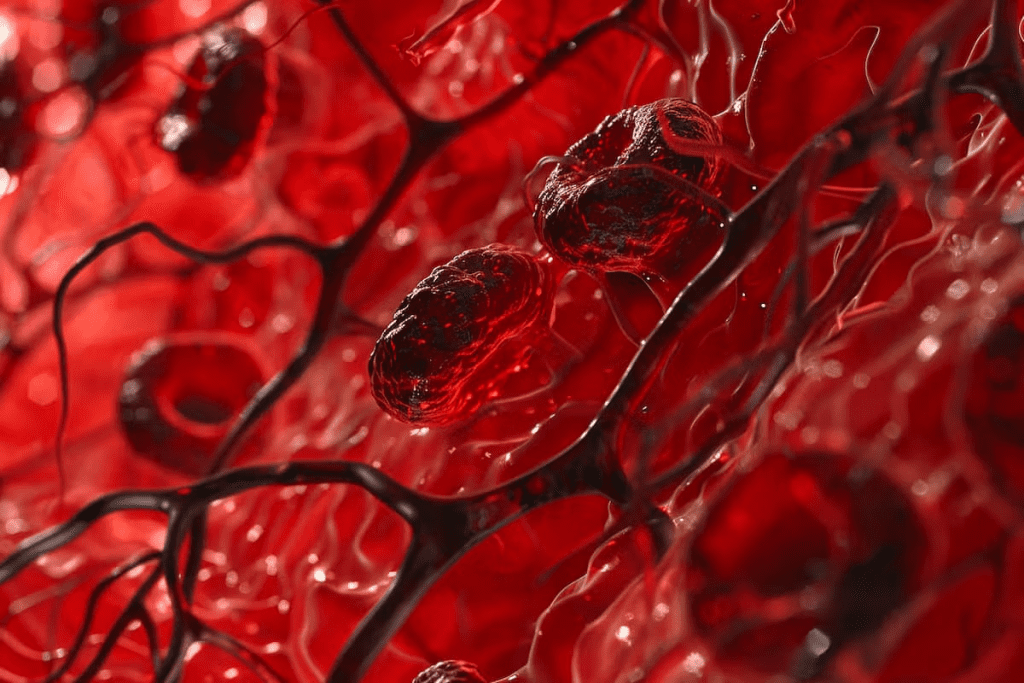Last Updated on November 13, 2025 by
What does hemolytic anemia look like on a CBC? Understand the hemolysis labs and the crucial signs of red blood cell destruction. Powerful knowledge for diagnosis.
Diagnosing hemolytic anemia often starts with a Complete Blood Count (CBC). This test helps spot signs of the condition. It shows when red blood cells are destroyed too quickly.

A CBC shows a lower red blood cell count and less hemoglobin in patients with this condition. These signs are important for doctors to diagnose and treat it well.
It’s key to know the CBC patterns that point to hemolytic anemia. This knowledge helps doctors give the best care to their patients. We’ll look at these patterns and the important numbers doctors need to know.
Hemolytic anemia is a complex condition where red blood cells are destroyed too quickly. This can happen inside or outside the blood vessels. Knowing how it works is key to finding the right treatment.
Hemolytic anemia means red blood cells are destroyed early. This can be due to genetic issues, autoimmune diseases, or infections. Symptoms include fatigue, jaundice, and shortness of breath because the blood can’t carry enough oxygen.
Red blood cells can be destroyed in the spleen (extravascular hemolysis) or in the blood vessels (intravascular hemolysis). Both ways can cause hemolysis symptoms that can be mild or severe.

Hemolytic anemias are divided into two types: inherited and acquired. Inherited types include sickle cell anemia and thalassemia, caused by genetic problems with hemoglobin.
Acquired types are caused by outside factors like autoimmune disorders, infections, and certain medications. These can lead to antibodies attacking red blood cells or direct damage, causing them to break down early.
Knowing the types and causes of hemolytic anemia is vital for treatment. Treatment plans can include managing symptoms, treating complications, or addressing the root cause.
The Complete Blood Count (CBC) is key in diagnosing anemia. It checks the blood’s different parts, like red and white blood cells, and platelets. Doctors often look at CBC results first when checking for anemia.
A CBC looks at important parts of blood for anemia diagnosis. These parts include:
The MCV is a key value from a CBC panel, known as “fbc mcv” or “cbc panel mcv.” It helps sort anemia types by red blood cell size.

Understanding CBC results means knowing the normal ranges. These vary by age and sex. For example, men usually have higher hemoglobin levels than women. Kids and teens have different ranges than adults.
Doctors must consider these differences when checking CBC results. They look at red blood cell count, hemoglobin, and hematocrit levels to see if they’re normal.
Looking at CBC results is key to spotting hemolytic anemia. The complete blood count shows how severe and what kind of anemia it is. This helps doctors decide what tests to do next and how to treat it.
A low red blood cell (RBC) count is a big sign of hemolytic anemia. This happens because RBCs are being destroyed too fast. The bone marrow can’t keep up with making new ones. Checking the RBC count helps doctors figure out if someone has anemia and how bad it is.
In hemolytic anemia, hemoglobin and hematocrit levels often drop. Hemoglobin is what carries oxygen in RBCs. Hematocrit is how much of the blood is made up of RBCs. Low levels mean someone has anemia and can show how severe it is.
Key findings include:
Red cell indices like mean corpuscular volume (MCV), mean corpuscular hemoglobin (MCH), and mean corpuscular hemoglobin concentration (MCHC) give important info. They tell us about the RBCs in hemolytic anemia. Changes in these can help find out why hemolysis is happening.
For example, a high MCHC might point to hereditary spherocytosis. This is when RBCs are shaped like spheres and break down easily. Knowing these changes helps doctors find the cause of hemolytic anemia.
Common red cell indices alterations include:
Reticulocytosis is a sign of the bone marrow’s effort to replace red blood cells lost due to hemolytic anemia. This response is key to keeping the body’s red blood cell count up. It ensures tissues get enough oxygen.
When red blood cells are destroyed, the bone marrow makes more reticulocytes. These are young red blood cells. An increase in reticulocytes, or reticulocytosis, shows the bone marrow is working hard to replace lost cells. It’s a sign the body is fighting back against hemolysis.
The reticulocyte count is important for checking how severe hemolytic anemia is. It also helps us see how well the bone marrow is responding to treatment. By looking at the reticulocyte count, we can understand the hemolytic process better. This helps us adjust treatment plans.
To really see how the bone marrow is reacting to hemolysis, we use the Reticulocyte Production Index (RPI). The RPI combines the reticulocyte count, hematocrit, and a correction factor. A high RPI means the bone marrow is responding well to hemolysis.
Understanding the RPI needs careful thought about the patient’s situation and lab results. By looking at the RPI along with other lab values, we get a clearer picture of the hemolytic disorder. This helps us create a better treatment plan.
In summary, reticulocytosis is a vital response to hemolytic anemia. It shows the bone marrow’s effort to replace lost red blood cells. By knowing about elevated reticulocyte counts and the Reticulocyte Production Index, we can better understand the hemolytic process. This helps us tailor treatments to each patient’s needs.
Looking at a peripheral blood smear is key in diagnosing hemolytic anemia. It lets us see red blood cells and other cells up close. This helps us figure out why the cells are breaking down.
A blood smear can show different shapes of red cells that hint at hemolytic anemia. For example, spherocytes are small and round, often seen in certain types of anemia. Schistocytes, or broken red cells, suggest damage from mechanical forces.
We might also see echinocytes and keratocytes, which have spiky or horn-like shapes. These shapes point to various causes of hemolytic anemia. Finding these shapes helps us narrow down what’s causing the problem.
A blood smear might also show nucleated red blood cells (NRBCs). These are young red cells that come out early because of too much breakdown. Seeing NRBCs means there’s a lot of cell loss or stress in the bone marrow.
Other signs include polychromasia, which means there are young red cells in the blood. This is the body’s way of trying to make up for lost cells. We might also see problems with white blood cells or platelets, which can give us more clues.
By studying the blood smear closely, we can learn a lot. This helps us figure out how to treat hemolytic anemia and understand hemogram mcv results better.
There are many tests beyond the CBC that help us understand hemolytic anemia. Hemolysis labs show how much red blood cells are being destroyed and how the body is trying to respond.These tests show how much red blood cells are being destroyed. They also show how the body is trying to make up for it.
Several tests show when red blood cells break down. Bilirubin levels go up when red cells are destroyed. This is because of the heme breakdown. We also check Lactate Dehydrogenase (LDH) levels, as high LDH means hemolysis.
Also, hemoglobinuria or hemosiderinuria can show that red cells are breaking down inside the blood vessels.
Haptoglobin and hemopexin are proteins that grab onto free hemoglobin from broken red cells. In hemolytic anemia, haptoglobin levels often drop because they get bound to hemoglobin. Hemopexin levels also go down in severe cases. Testing these proteins helps us see how bad the hemolysis is.
Using these extra tests, we can understand hemolytic anemia better. This helps us make better treatment plans.
It’s important to know the difference between intravascular and extravascular hemolysis to treat hemolytic anemia well. Hemolytic anemia happens when red blood cells are destroyed. This can happen inside blood vessels (intravascular) or outside, like in the spleen and liver (extravascular).
Lab tests, like the Complete Blood Count (CBC), help tell the difference. A high lactate dehydrogenase (LDH) level often means intravascular hemolysis.
Extravascular hemolysis shows up as higher bilirubin levels, mainly indirect bilirubin. This is because red blood cells break down in the spleen and liver. The CBC also shows signs of anemia, like low hemoglobin and hematocrit, and high reticulocyte count. This is the bone marrow’s way of making up for lost red blood cells.
Hemoglobinuria and hemosiderinuria are signs of intravascular hemolysis. Hemoglobinuria is when hemoglobin is found in the urine. This happens when there’s too much hemoglobin for haptoglobin to bind, leading to kidney excretion. Hemosiderinuria is when hemosiderin, a byproduct of hemoglobin breakdown, is in the urine. It shows chronic intravascular hemolysis.
These signs are key for diagnosing intravascular hemolysis. They help tell it apart from extravascular hemolysis. Hemoglobinuria and hemosiderinuria suggest conditions like paroxysmal nocturnal hemoglobinuria (PNH) or problems with mechanical heart valves.
It’s key to know the CBC patterns for specific hemolytic disorders for accurate diagnosis and treatment. Hemolytic anemias are a group of conditions where red blood cells are destroyed early. By looking at the CBC patterns, we can understand these disorders better and find the right treatments.
Inherited hemolytic anemias come from genetic mutations that affect red blood cells. Sickle cell anemia and thalassemia are two common ones.
Sickle Cell Anemia: This is caused by a mutation in the HBB gene, making abnormal hemoglobin (HbS). The CBC shows:
Thalassemia: Thalassemia is due to mutations in the HBA or HBB genes, leading to less or no alpha or beta globin chains. The CBC findings are:
Acquired hemolytic anemias are caused by external factors or secondary conditions. Autoimmune hemolytic anemia (AIHA) is a common example.
Autoimmune Hemolytic Anemia (AIHA): In AIHA, the immune system attacks the patient’s own red blood cells. The CBC may show:
Understanding the CBC patterns is vital for diagnosing and managing these conditions. By recognizing these patterns, we can give more accurate diagnoses and effective treatments for hemolytic anemias.
It’s important to know the difference between acute hemolysis and chronic hemolytic states. This helps doctors diagnose and treat patients better. Hemolytic anemia can show up in different ways, and knowing the type is key.
Acute hemolysis means red blood cells are destroyed quickly. This can cause symptoms to appear fast. It’s a serious condition that needs quick medical help.
Lab tests show clear signs of acute hemolysis. A Complete Blood Count (CBC) might show low hemoglobin and hematocrit levels. But, it will also show a high reticulocyte count, as the bone marrow tries to make up for the loss.
Laboratory findings in acute hemolysis may include:
Chronic hemolytic states mean red blood cells are destroyed over time. The bone marrow can keep up, so hemoglobin levels stay stable. This is different from acute hemolysis.
The CBC patterns in chronic compensated hemolysis may include:
Spotting these patterns is vital for managing chronic hemolytic conditions well.
Identifying hemolytic anemia requires a clear diagnostic algorithm. We start with lab tests to confirm hemolysis. Then, we do more tests to find the cause.
The first step is a Complete Blood Count (CBC) and reticulocyte count. The CBC shows hemoglobin, hematocrit, and red blood cell details. The reticulocyte count checks the bone marrow’s response.
“A CBC is the first step in evaluating anemia and can indicate hemolysis through findings such as anemia, reticulocytosis, and specific red blood cell morphologies”.
Low hemoglobin and high MCV can point to hemolytic anemia. The presence of spherocytes or schistocytes on the smear is also a clue. An elevated reticulocyte count shows the bone marrow is working hard to replace lost red blood cells.
After initial findings suggest hemolytic anemia, we do more tests. These include haptoglobin, lactate dehydrogenase (LDH), and indirect bilirubin tests. Low haptoglobin and high LDH levels suggest intravascular hemolysis.
Tests like direct and indirect Coombs tests help diagnose autoimmune hemolytic anemia. Hemoglobin electrophoresis and osmotic fragility testing are used for other conditions. The choice of tests depends on the initial findings and clinical context.
In conclusion, diagnosing hemolytic anemia follows a systematic process. It starts with a CBC and reticulocyte count, then moves to specialized tests. This approach ensures accurate diagnosis and proper treatment.
Tracking treatment response is key in managing hemolytic anemia. This is done through serial CBCs. It helps healthcare providers see if the treatment is working and if changes are needed.
Several important parameters are monitored through serial CBCs:
Serial CBCs also spot complications or disease worsening. Look out for these signs:
By watching these closely, healthcare providers can adjust treatments. This helps improve outcomes for patients with hemolytic anemia.
We’ve looked into hemolytic anemia, a condition where red blood cells break down too early. We’ve seen how Complete Blood Count (CBC) results and other tests help us understand it better.
CBC results are key in spotting hemolytic anemia. They show us the count of red blood cells and their hemoglobin levels. By looking at these, along with other tests, we can find the cause and treat it.
Our talk has shown how important it is to use CBC results and other tests together. This way, we can give better care to those with hemolytic anemia and help them get better.
Symptoms of hemolysis include fatigue, jaundice, dark urine, and shortness of breath. These happen because red blood cells are being destroyed. The body can’t keep up with the loss.
A CBC helps diagnose hemolytic anemia. It looks at RBC count, hemoglobin, hematocrit, and red cell indices. Low RBC count, hemoglobin, and hematocrit, along with changes in red cell indices, point to hemolytic anemia.
Reticulocyte count is key in diagnosing hemolytic anemia. It shows if the bone marrow is making more RBCs to replace lost ones. An elevated count means the bone marrow is working hard to keep up.
Intravascular hemolysis happens inside blood vessels. Extravascular hemolysis happens outside, like in the spleen. Tests like CBC and haptoglobin levels can tell them apart.
The severity of hemolytic anemia is measured by the reticulocyte production index. It also looks at hemoglobin and hematocrit levels. This shows how much RBCs are being destroyed and how the bone marrow is responding.
Peripheral blood smear evaluation is important in hemolytic anemia. It helps find specific red cell shapes and other cell problems. This information is vital for diagnosis and treatment.
Treatment response is tracked by looking at RBC count, hemoglobin, and hematocrit through CBCs. This helps spot signs of worsening disease or complications.
Signs of acute hemolysis include a sudden drop in hemoglobin and hematocrit. There’s also an elevated reticulocyte count and increased markers of red cell breakdown, like LDH and bilirubin.
The diagnostic process for suspected hemolytic anemia starts with a CBC and reticulocyte count. Then, it moves to specialized tests like peripheral blood smear and markers of red cell breakdown.
The most common cause of hemolytic anemia varies by population and location. Inherited conditions like sickle cell disease and thalassemia are common. So are acquired conditions, such as autoimmune hemolytic anemia.
Subscribe to our e-newsletter to stay informed about the latest innovations in the world of health and exclusive offers!